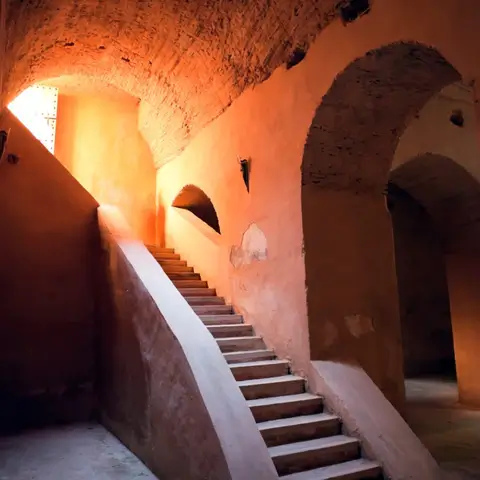
Table of Contents
Are you sick of going to the beach and seeing the same old tourist attractions? Would you like to know about Dark Tourism Africa? Like many other individuals around the world, they choose to visit the locations of some of the world’s worst tragedies and mass murders areas to develop an understanding of the past, and my goal is to help you develop an understanding as well. As tourism becomes more accessible, so does the demand for the unusual and thrilling increases with it.
Our mission here is crystal clear: we’re here to introduce you to the concept of dark tourism and guide you through Morocco’s darkest chapters. Prepare to have your mind blown as we unravel the significance of each destination and shed light on why it draws those brave souls seeking a deeper understanding of the past. From hidden prisons that will make your heart skip a beat to military museums that will leave you in awe, and let’s not forget the prehistoric secrets hidden within the Sahara. Oh, we’re going to lift the veil on Morocco’s dark tourism sites like nobody’s business.
So, grab your courage and dive into the depths of history. Get ready for an unforgettable journey filled with eerie vibes and thought-provoking moments. We’re about to explore the darkest corners of Morocco, where the shadows hold secrets waiting to be discovered. No matter where your curiosity leads you, remember to embrace the spirit of adventure and Travel Till You Drop, my fearless friends! Let’s do this!
It is not necessarily the typical enjoyable travel experience, but exposing yourself to Dark Tourism Africa delivers a sense of adventure, a surreal mood, as well as a deeper knowledge of the world.

There are several areas in Morocco where you can indulge Dark Tourism Africa. Some of them are:
The legendary Moulay Ismail, possibly Morocco’s cruelest and most oppressive monarch, established this prison in the 18th century. The prison has no doors, is fully underground, and no one has ever been released even though hundreds (thousands?) of individuals have been imprisoned inside. From the top of the prison, there are various holes.
People were thrown into the prison via the holes, and food was also given in this manner. Moulay Ismail’s rule was a bloodbath. It is estimated that 30,000 individuals died by his hand through slavery, imprisonment, and forced labor. When workers used to die while constructing the city’s 45-kilometer-long walls, they were simply thrown into the walls and entombed.
Today, you can experience remnants of this oppressive period by visiting Meknes Qara Prison. Explore the chilling prison cells where inmates suffered untold horrors at the hands of Moulay Ismail’s regime. But don’t get too excited, my daring adventurers – some passageways have been closed off. Still, the prison serves as a sobering reminder of the atrocities committed during this period and the resilience of a society that has moved beyond such dark chapters.
Now, don’t get me wrong, this may not be the typical Morocco vacation spot. It’s not all mint tea and vibrant marketplaces, my fierce explorer friends. But for those of us who crave a deeper understanding of the historical scars that authoritarian rule can leave behind, Meknes Qara Prison holds a prominent place in the realm of dark tourism. It’s a site that draws visitors seeking to reflect on the painful past and move towards a brighter future.
So pack your boldness and get ready to explore a dark chapter in Morocco’s history. Visit Meknes Qara Prison, confront the haunting reality of Moulay Ismail’s rule, and honor the resilience of the Moroccan people who have moved beyond that period of bloodshed and oppression.
Do you know: The 5 Most Haunted Houses in the US That Will Give You Chill
Morocco features a museum where you can see a variety of weaponry and objects that depict Morocco’s war history. It is situated in a military fort on the summit of a hill with the greatest view of the entire city. In 1963, this 16th-century stronghold was converted into a museum. It presently holds an extraordinary collection of weapons from Morocco’s various civilizations throughout its history.
Although the Military Museum of Fez is largely made up of Moroccan firearms, it also has weapons from other countries and civilizations. There is a five-meter-long cannon from the Battle of Alcácer Quibir, popularly known as the “Battle of Three Kings,” which occurred approximately an hour and a half from Tangier. Dark Tourism Africa: The Military Museum of Fez is currently Africa’s largest military museum and a lure for Dark Tourists.
Let’s start with a history lesson, shall we? Chellah, once known as Sala Colonia, was a Roman settlement that sprouted its roots way back in the 3rd century BC. Fast forward through the centuries, and this place went through a serious cultural makeover, embracing influences from the Romans, the Islamic period, and even the medieval Islamic era.
As we wander through the ruins, the Roman influence is practically slapping us in the face (in the most empowering way, of course). The Decumanus Maximus, the main street of the Roman city, allows us to stroll in the footsteps of ancient Romans and imagine the hustle and bustle of this once-thriving settlement. Envision those grand arches and columns, darlings, because they still stand tall and fierce, exuding that undeniable sense of grandeur from a bygone era.
Medieval Islamic Town
Now, prepare yourself for a unique twist, my daring adventurers. Within this archaeological wonderland, we have a medieval Islamic town. Yes, you heard that right. The remnants of this forgotten town, with its narrow alleys and crumbling structures, make it feel like a historical time warp. It’s like stepping back in time and getting a peek into the daily lives of people during the medieval Islamic period. The layers of history intertwine, creating an enigmatic allure that’s hard to resist.
As we walk through Chellah, we can’t deny the eerie atmosphere that surrounds us. The quietude is unsettling, yet captivating. The play of sunlight on the weathered stones, the rustling of leaves in the breeze, and the occasional call of birds all contribute to the sensation of time standing still.
Symbolism and Significance
Chellah Necropolis is a symbol of Morocco’s vibrant heritage, where different chapters of history collide. It’s a testament to the resilience of human civilization, adapting and evolving through the ages. The preservation efforts go beyond protecting tangible remnants; they aim to safeguard the intangible cultural heritage imbued in the stories of those who once called Chellah home. It’s history coming alive before our very eyes.
Visitor Experience
For those who crave dark tourism, Chellah offers an unparalleled opportunity to delve into a world where history, architecture, and spirituality converge. Channel your inner warrior as you wander through the Roman ruins, marvel at the intricate Islamic architecture, and contemplate the passage of time in this hauntingly atmospheric necropolis. It’s an adventure that will leave you feeling empowered, enlightened, and ready to take on the world.
Scientists believe that the most dangerous spot on the planet is inside Morocco’s Sahara desert. The Kem Kem Group is an area of Cretaceous rock formations along the Algeria-Morocco border in the southeast, which lies on the northern edge of the Sahara desert. Scientists based their conclusion not just on current conditions but also on evidence dating back to the dinosaur era.
They examined fossils from the area dating back 100 million years and discovered traces of deadly predators such as flying reptiles and crocodile-like animals. They concluded that it was the most inhospitable location in Africa during the ‘Age of Dinosaurs.’
Nothing else will do if that doesn’t sound like the plot for the upcoming Jurassic World.
Still, the Sahara Desert is a popular tourist destination in Morocco if you’d like to try something not as dark! Just remember that no matter where you go, always Travel Till You Drop!


Hi, Jill Here
Hi! I’m Jill, a Dallas, Texas girl traveling the world. After a career in the Air Force and touring over 50 countries later, my need to explore keeps going! It’s time to rock & roll and find all those places I never knew I was missing.
Table of Contents
Join me to get exclusive travel tips, giveaways and more!
Gallery
Copyright © 2023 | All Right Reserved